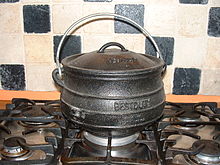Potjiekos
Potjiekos (derived from the Afrikaans nouns potjie "small pot" and kos "food", "food") is a traditional South African stew that is slowly cooked over a wood fire in a large, round three-legged cast iron vessel with a loosely attached lid.
The cast iron cauldron, like the stew that was braised in it - the hutspot - has its origins in the Netherlands . In 1652 the vessel and the cooking method used for it came to the Cape of Good Hope with Dutch settlers . During the great trek of the Boer Voortrekker into the interior of South Africa, the vessel gradually found its way to the black population. Today it can be found in all rural areas of southern Africa.
Cultural history
The origin of the South African Potjiekos can be traced back to the Eighty Years War (1568–1648), when the Dutch waged their war of freedom against the Spanish. When the city of Leiden was besieged by Spanish troops towards the end of the war, the starving population began to cook everything edible in large cast-iron pots. Only later, in times of peace, was the dish born of necessity gradually refined with spices and more exquisite ingredients.
At the Cape, the stew, which the Dutch called hutspot , was further developed thanks to the plentiful supply of food. It was mainly hunters and nomadic farmers who trekking who, for convenience, carried cast-iron vessels for food preparation with them - these could be hung on a hook in ox wagons, needed comparatively little firewood and did not have to braise while the food was slowly simmering be further supervised.
Usually the Treckburen only carried the bare minimum of food with them - flour, rice, sometimes dried or salted meat, but no fresh ingredients such as vegetables. Food of vegetable origin - called veldkos - could be picked on occasion, and fresh game meat was hunted. If necessary, bread could also be "baked" in the cast iron pot while the potjiekos were braising. The prepared dough was finally placed in the vessel filled in layers and cooked on top in the hot steam.
During the Boer War, Boer fighters, who only got around on horseback, were unable to carry heavy cookware with them. So Potjiekos was stewed in tinned meat cans. The men were supplied with food by women from nearby farms.
After the war, Potjiekos continued to enjoy great popularity. Braising the potjiekos over an open fire became a weekend fun and the focus of a social get-together. Traditionally, the role of women was limited to shopping and preparing the ingredients, while the male host oversaw the casserole and fire.
Potjiekos is today - along with Boerewors , Biltong , Melktert, Koeksisters , Afval and Bobotie - in its countless variations an integral part of traditional South African cuisine and a popular leisure activity that, thanks to the immigration of South Africans, is also spreading in Great Britain, Australia, New Zealand and the Netherlands has become an important social link. The invitation to a potjiekos meal is equivalent to the acceptance into the closer circle of friends of the host.
Potjiekos cooking competitions are very popular all over South Africa, while the African singer Anton Goosen has dedicated a song to the dish. The Voortrekkers , a cultural association of Afrikaans-speaking South Africans, only awards their armband emblem after successfully completing a Potjiekos course.
Individual evidence
- ^ Just Food Now: Potjiekos. Retrieved on July 16, 2014 ( Memento of the original from July 23, 2014 in the Internet Archive ) Info: The archive link was inserted automatically and has not yet been checked. Please check the original and archive link according to the instructions and then remove this notice.



